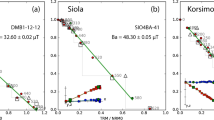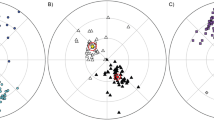Abstract
Many palaeomagnetists believe that, when properly measured, geomagnetic intensities can be obtained with a precision of better than 10% (R. S. Coe, personal communication). But published results do not appear to support this view1–5: the reproducibility of intensities are, not only from laboratory to laboratory1,2, but also within laboratories3–5, in the range 50–100%, whether the Thelliers6 method or the Shaw7 method is used8. As the precision of laboratory techniques is a few per cent, the most likely source of errors of this magnitude is mineral alteration due to heating during sample processing. Here I describe a technique capable of measuring the effect of alteration, allowing its contribution to be subtracted from the data. This work also shows that these errors can be systematic, confirming a previous finding9.
This is a preview of subscription content, access via your institution
Access options
Subscribe to this journal
Receive 51 print issues and online access
$199.00 per year
only $3.90 per issue
Buy this article
- Purchase on Springer Link
- Instant access to full article PDF
Prices may be subject to local taxes which are calculated during checkout
Similar content being viewed by others
References
1. Thomas, R. in Archaeomagnetism of Baked Clays and Recent Sediments (eds Creer, K. M., Tucholka, P. & Barton, C. E.) 118 (Elsevier, Amsterdam, 1983). 2. Sternberg, R. in Archaeomagnetism of Baked Clays and Recent Sediments (eds Creer, K. M., Tucholka, P. & Barton C. E.) 168 (Elsevier, Amsterdam, 1983). 3. Kovacheva, M. in Archaeomagnetism of Baked Clays and Recent Sediments (eds Creer, K. M., Tucholka, P. & Barton C. E.) 110 (Elsevier, Amsterdam, 1983). 4. Wei, Q. Y. et al. in Archaeomagnetism of Baked Clays and Recent Sediments (eds Creer, K. M., Tucholka, P. & Barton, C. E.) 147 (Elsevier, Amsterdam, 1983). 5. Barbetti, M. in Archaeomagnetism of Baked Clays and Recent Sediments (eds Creer, K. M., Tucholka, P. & Barton, C. E.) 175 (Elsevier, Amsterdam, 1983). 6. Thellier E. & Thellier, O. Ann. Geophys. 15, 295–296 (1959). 7. Shaw, J. Geophys. J. R. astr. Soc. 39, 133–141 (1974). 8. Kristjansson, L. Geophys. J. R. astr. Soc. 80, 555–559 (1985). 9. Walton, D. Nature 315, 374–375 (1985). 10. Coe, R. S. /. Geomagn. Geoelectr. 19, 157–159 (1967). 11. Coe, R. S. & Gromme, C. S. / Geomagn. Geoelectr. 25, 415–435 (1973). 12. Prevot, M., Mankinen, E. A., Gromme, C. S. & Lecaille, A. / geophys. Res. 88, 2316–2326 (1983). 13. Coe, R. S., Gromme, C. S. & Mankinen, E. A. J. geophys. Res. 89, 1059–1069 (1984). 14. Walton, D. in Geomagnetism of Baked Clays and Recent Sediments (eds Creer, K. M., Tucholka, P. & Barton, C. E.) 90–91 (Elsevier, Amsterdam 1983). 15. Walton, D. Nature 286, 245–247 (1980). 16. Walton, D. Nature 310, 740–743 (1984). 17. Aitken, M. J., Allsop, A. L., Bussell, G. D. & Winter, M. Nature 314, 752–753 (1985). 18. Tanguy, J. C. Earth planet. Sci. Lett. 27, 314–320 (1975). 19. Fox, J. M. W. & Aitken, M. J. Nature 283, 462–463 (1980). 20. Williams, W. thesis, Univ. Cambridge (1986). 21. Walton, D. /. Geomagn. Geoelectr. 38, 1349–1352 (1986).
Author information
Authors and Affiliations
Rights and permissions
About this article
Cite this article
Walton, D. Improving the accuracy of geomagnetic intensity measurements. Nature 328, 789–791 (1987). https://doi.org/10.1038/328789a0
Received:
Accepted:
Issue Date:
DOI: https://doi.org/10.1038/328789a0
This article is cited by
-
Effect of magnetic anisotropy on the experimentally determined palaeointensity of the geomagnetic field
Earth, Planets and Space (2001)
-
Long-term polarity stability and strength of the geomagnetic dipole
Nature (1988)
-
Use and abuse of intensity data
Nature (1987)
Comments
By submitting a comment you agree to abide by our Terms and Community Guidelines. If you find something abusive or that does not comply with our terms or guidelines please flag it as inappropriate.



